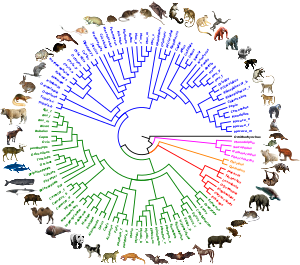
Ungulates are members of the diverse clade Euungulata, which primarily consists of large mammals with hooves. Once part of the clade "Ungulata" along with the clade Paenungulata, "Ungulata" has since been determined to be a polyphyletic and thereby invalid clade based on molecular data. As a result, true ungulates had since been reclassified to the newer clade Euungulata in 2001 within the clade Laurasiatheria while Paenungulata has been reclassified to a distant clade Afrotheria. Living ungulates are divided into two orders: Perissodactyla including equines, rhinoceroses, and tapirs; and Artiodactyla including cattle, antelope, pigs, giraffes, camels, sheep, deer, and hippopotamuses, among others. Cetaceans such as whales, dolphins, and porpoises are also classified as artiodactyls, although they do not have hooves. Most terrestrial ungulates use the hoofed tips of their toes to support their body weight while standing or moving. Two other orders of ungulates, Notoungulata and Litopterna, both native to South America, became extinct at the end of the Pleistocene, around 12,000 years ago.

Placental mammals are one of the three extant subdivisions of the class Mammalia, the other two being Monotremata and Marsupialia. Placentalia contains the vast majority of extant mammals, which are partly distinguished from monotremes and marsupials in that the fetus is carried in the uterus of its mother to a relatively late stage of development. The name is something of a misnomer considering that marsupials also nourish their fetuses via a placenta, though for a relatively briefer period, giving birth to less developed young which are then nurtured for a period inside the mother's pouch. Placentalia represents the only living group within Eutheria, which contains all mammals more closely related to placentals than to marsupials.

Elephant shrews, also called jumping shrews or sengis, are small insectivorous mammals native to Africa, belonging to the family Macroscelididae, in the order Macroscelidea. Their traditional common English name "elephant shrew" comes from a perceived resemblance between their long noses and the trunk of an elephant, and their superficial similarity with shrews in the order Eulipotyphla. However, phylogenetic analysis has revealed that elephant shrews are not properly classified with true shrews, but are in fact more closely related to elephants than to shrews. In 1997, the biologist Jonathan Kingdon proposed that they instead be called "sengis", a term derived from the Bantu languages of Africa, and in 1998, they were classified into the new clade Afrotheria.
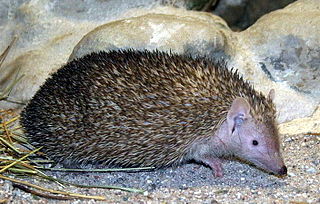
The clade Afrosoricida contains the golden moles of Southern Africa, the otter shrews of equatorial Africa and the tenrecs of Madagascar. These three groups of small mammals were for most of the 19th and 20th centuries regarded as a part of the Insectivora or Lipotyphla, but both of those groups, as traditionally used, are polyphyletic.
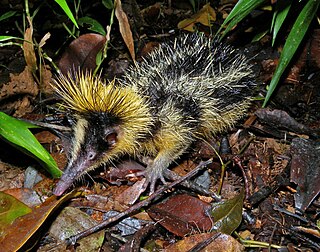
Tenrecomorpha is the suborder of otter shrews and tenrecs, a group of afrotherian mammals indigenous to equatorial Africa and Madagascar, respectively. The two families are thought to have split about 47–53 million years ago. Potamogalid otter shrews were formerly considered a subfamily of Tenrecidae. The suborder is also presumed to contain the extinct genus Plesiorycteropus, a group of possibly fossorial insectivores similar to aardvarks, which is known to be more closely related to tenrecs of subfamily Tenrecinae than to golden moles of suborder Chrysochloridea.

A tenrec is a mammal belonging to any species within the afrotherian family Tenrecidae, which is endemic to Madagascar. Tenrecs are a very diverse group; as a result of convergent evolution, some resemble hedgehogs, shrews, opossums, rats, and mice. They occupy aquatic, arboreal, terrestrial, and fossorial environments. Some of these species, including the greater hedgehog tenrec, can be found in the Madagascar dry deciduous forests. However, the speciation rate in this group has been higher in humid forests.

Paenungulata is a clade of "sub-ungulates", which groups three extant mammal orders: Proboscidea, Sirenia, and Hyracoidea (hyraxes). At least two more possible orders are known only as fossils, namely Embrithopoda and Desmostylia.
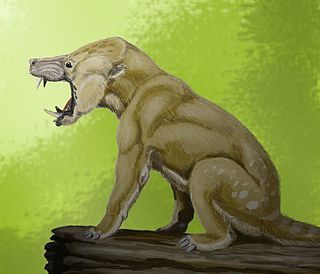
Condylarthra is an informal group – previously considered an order – of extinct placental mammals, known primarily from the Paleocene and Eocene epochs. They are considered early, primitive ungulates. It is now largely considered to be a wastebasket taxon, having served as a dumping ground for classifying ungulates which had not been clearly established as part of either Perissodactyla or Artiodactyla, being composed thus of several unrelated lineages.

South American native ungulates, commonly abbreviated as SANUs, are extinct ungulate-like mammals of controversial affinities that were indigenous to South America prior to the Great American Biotic Interchange. They comprise five major groups conventionally ranked as orders—Astrapotheria, Litopterna, Notoungulata, Pyrotheria, and Xenungulata—as well as the primitive "condylarth" groups Didolodontidae and Kollpaniinae. It has been proposed that some or all of the members of this group form a clade, named Meridiungulata, though the relationships of South American ungulates remain largely unresolved. The two largest groups of South American ungulates, the notoungulates and the litopterns, were the only groups to persist beyond the mid Miocene. Only a few of the largest species of notoungulates and litopterns survived until the end-Pleistocene extinction event around 12,000 years ago where they became extinct with most other large mammals in the Americas, shortly after the first arrival of humans into the region.

Cimolesta is an extinct order of non-placental eutherian mammals. Cimolestans had a wide variety of body shapes, dentition and lifestyles, though the majority of them were small to medium-sized general mammals that bore superficial resemblances to rodents, lagomorphs, mustelids, and marsupials.
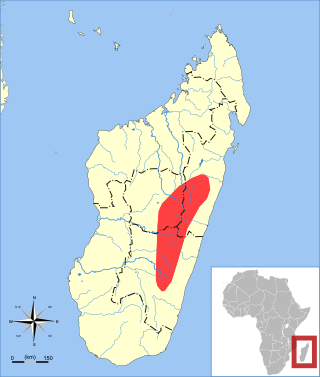
The web-footed tenrec, Malagasy otter shrew, or aquatic tenrec is the only known semiaquatic tenrec, and is found in eastern Madagascar, especially in and around Ranomafana National Park. It grows to between 25 and 39 cm, and was once thought to be extinct. It feeds on crabs, aquatic insects, and crayfish. The population is considered vulnerable. It was formerly placed in the monotypic genus Limnogale, but has been moved to Microgale based on molecular data showing it to be deeply nested within the latter.

The Afroinsectiphilia is a clade that has been proposed based on the results of recent molecular phylogenetic studies. Many of the taxa within it were once regarded as part of the order Insectivora, but Insectivora is now considered to be polyphyletic and obsolete. This proposed classification is based on molecular studies only, and there is no morphological evidence for it.

Ferungulata is a grandorder of placental mammals that groups together mirorder Ferae and clade Pan-Euungulata. It has existed in two guises, a traditional one based on morphological analysis and a revised one taking into account more recent molecular analyses. The Fereungulata is a sister group to the order Chiroptera (bats) and together they make clade Scrotifera.
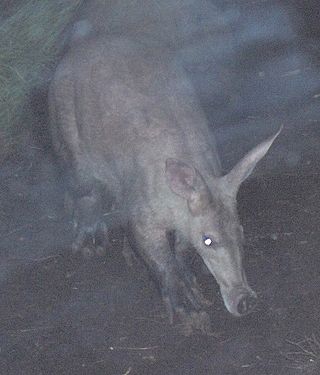
Pseudoungulata, or "false hoofed mammals", is a possible clade made up of two subgroups, aardvarks and paenungulates. Before this group was proposed, it was thought that aardvarks were more closely related to xenarthrans. However, all of these mammals are now considered to be part of Afrotheria, which also includes elephant shrews and afrosoricidans. Other positions of aardvarks within Afrotheria are possible, such as being closest relatives of elephant shrews and/or afrosoricidans.

Amblysomus is a genus of the golden mole family, Chrysochloridae, comprising five species of the small, insect-eating, burrowing mammals endemic to Southern Africa. All five species can be found in South Africa and some are also found in Eswatini and Lesotho.

Potamogalidae is the family of "otter shrews", a group of semiaquatic riverine afrotherian mammals indigenous to sub-Saharan Africa. They are most closely related to the tenrecs of Madagascar, from which they are thought to have split about 47–53 million years ago. They were formerly considered a subfamily of Tenrecidae.

Ptolemaiida is a taxon of wolf-sized afrothere mammals that lived in northern and eastern Africa during the Paleogene. The oldest fossils are from the latest Eocene strata of the Jebel Qatrani Formation, near the Fayum oasis in Egypt. A tooth is known from an Oligocene-aged stratum in Angola, and Miocene specimens are known from Kenya and Uganda.

Phenacodontidae is an extinct family of large herbivorous mammals traditionally placed in the “wastebasket taxon” Condylarthra, which may instead represent early-stage perissodactyls. They lived from the late early Paleocene to early middle Eocene and their fossil remains have been found in North America and Europe. The only unequivocal Asian phenacodontid is Lophocion asiaticus.
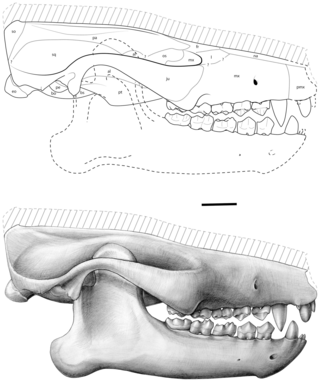
Ocepeia is an extinct genus of afrotherian mammal that lived in present-day Morocco during the middle Paleocene epoch, approximately 60 million years ago. First named and described in 2001, the type species is O. daouiensis from the Selandian stage of Morocco's Ouled Abdoun Basin. A second, larger species, O. grandis, is known from the Thanetian, a slightly younger stage in the same area. In life, the two species are estimated to have weighed about 3.5 kg (7.7 lb) and 10 kg (22 lb), respectively, and are believed to have been specialized leaf-eaters. The fossil skulls of Ocepeia are the oldest known afrotherian skulls, and the best-known of any Paleocene mammal in Africa.

Paenungulatomorpha is a clade of afrotherian mammals that can be characterized according to Gheerbrant et al. (2016):
by a mandibular retromolar fossa, the absence of hypocone, an ectoloph selenodont and linked to strong styles such as mesostyle in basal taxa, and a more or less developed pseudohypocone.

